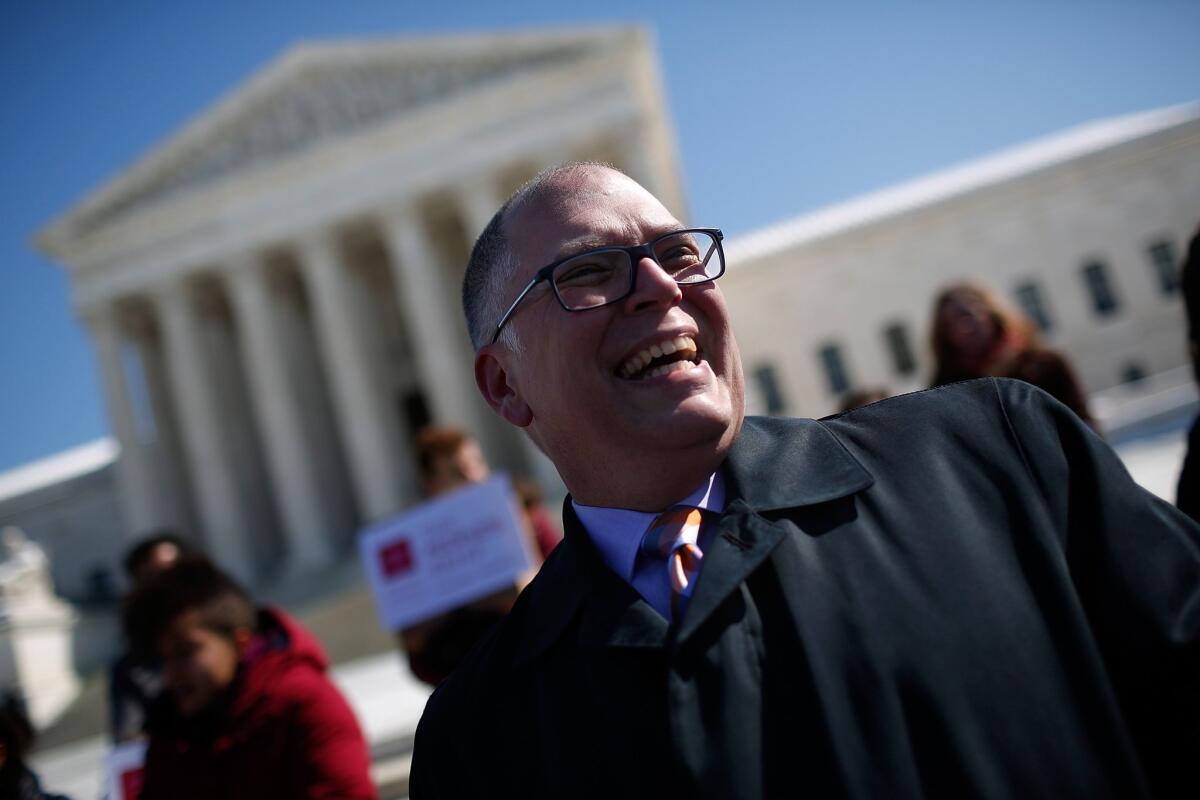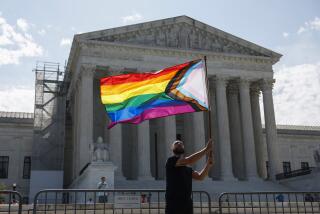At center of Supreme Court gay marriage case, a story of love amid crippling disease

Jim Obergefell, plaintiff in the case Obergefell vs. Hodges, speaks in front of the
Reporting from Washington — There are more than 30 plaintiffs in the gay marriage lawsuits that will be argued before the Supreme Court this month. But the case that will go down in history is named for just one, Jim Obergefell, a 48-year-old real estate salesman from Cincinnati who is battling Ohio over a word the state wants to write on his late husband’s death certificate: “single.”
The naming of the multiple consolidated gay marriage suits as Obergefell vs. Hodges was a clerical fluke, but the story behind it is one of the most unusual and poignant of the cases to be decided by the justices in June. It is a story of love amid a crippling disease, a triumphant wedding ceremony aboard a chartered medical jet on the tarmac in Baltimore, and then a legal battle over whether Obergefell’s three-month marriage to a dying John Arthur would be recognized on a piece of paper after he was gone.
“Here’s the last official record of John as a person, and it would be wrong,” said Obergefell, interviewed Sunday on the steps of the Supreme Court building, where the unassuming former corporate consultant never imagined himself.
The justices are widely expected to rule in favor of legalized gay marriage nationwide. But they also asked to hear arguments April 28 on a possible smaller step, letting states resolve the issue but forcing those where same-sex marriage is illegal to recognize unions performed in other states. That dispute is at the heart of Obergefell’s suit.
Obergefell and Arthur had been together for 20 years, often working side by side as consultants in Cincinnati for corporations like Oracle. They wanted to marry, but Ohio banned same-sex marriage. They didn’t want to marry in another state because it would have been a “symbolic” union invalid at home.
Two years ago, when the Supreme Court struck down the federal Defense of Marriage Act, they began to reconsider. The fact that Arthur had been diagnosed with amyotrophic lateral sclerosis, or ALS, a fatal, crippling neurological disorder often called Lou Gehrig’s disease after the baseball player, added “a much greater sense of urgency,” Obergefell said.
“With John’s death approaching, it just gave us more of an impetus and more of a desire to have our relationship validated and recognized,” Obergefell recalled. “We suddenly saw the opportunity to say ‘I do’ and have it matter from a legal and governmental perspective. But if John had not been dying from ALS, we still likely would have gotten married because after 20 and a half years together we wanted to be treated the same as other couples.”
Arthur’s worsening condition created additional obstacles to their plans.
“When we decided, ‘Let’s try and make this happen,’ at that point [John] was bedridden and in hospice care at home,” Obergefell said. “All he could do was move his right hand and his head a little, and speak.”
The couple decided to marry in Maryland, which offered simpler licensing requirements. But Obergefell did not think Arthur could make it by car. The only feasible option seemed to be chartering a medical jet at a cost of $13,000.
When he posted their financial dilemma on Facebook, friends and family quickly raised the money.
They never left the plane in Baltimore. On July 11, 2013, Arthur’s aunt, Paulette Roberts, performed the marriage, having ordained herself a minister for the occasion online. Each of them said, “I thee wed,” Arthur with some difficulty. A newspaper photographer came aboard to capture the moment.
The couple quickly discovered that the ceremony made a difference in their relationship. “We just felt different, having that government recognition of our relationship,” Obergefell said. “Having the government say you exist, you count.”
When they got back to Cincinnati there were 30 friends to greet them on the tarmac.
But mindful that Arthur’s disease was likely to claim his life soon, the couple set out on one final mission: to ensure that his death certificate would reflect their legal marriage.
Their lawyer, Alphonse Gerhardstein, warned them that it would be an uphill legal battle, but he filed an emergency suit in federal court.
Eleven days after their wedding, a federal judge ordered Ohio to issue the word “married” on the death certificate when Arthur died. Like many other gay marriage rulings around the country, it was based on the 2013 Supreme Court decision striking down part of the federal Defense of Marriage Act.
Arthur died on Oct. 22, three months after their wedding. Because of the court decision, he was listed as married to Obergefell at the time of death. But Ohio appealed and won a year later. It was the first time since the 2013 Supreme Court decision in Windsor vs. U.S. that a federal appeals judge had ruled against gay marriage.
Deciding six cases from four states, including Obergefell’s, the U.S. 6th Circuit Court of Appeals in Cincinnati said that the people, not the courts, should decide such fundamental issues. “Is it not possible that the traditional arbiters of change - the people - will meet today’s challenge admirably and settle the issue in a productive way?” asked Judge Jeffrey S. Sutton.
If the Supreme Court does not overturn the lower court, Ohio will not have to recognize same-sex marriages from other states, and it can reissue the death certificate and stamp it “single.”
“The indignity of the state of Ohio disregarding our marriage, it was devastating,” Obergefell said of the court defeat. He appealed to the Supreme Court.
Ohio said in its brief to the Supreme Court that its policy is rooted in democracy and its voters’ understanding of traditional marriage. It was not a matter of prejudice against gays, the state said.
“To hold that Ohio laws were driven by animus would demean millions of Ohioans by treating their deeply held beliefs about marriage as sheer bigotry,” the state’s lawyers said.
Obergefell’s attorneys counter that Ohio is engaged in unconstitutional discrimination “by singling out for disfavored treatment same-sex couples married by other states in order to mark those marriages as unequal.”
Obergefell has been distracted from his new career as a real estate agent by repeated requests by the Human Rights Campaign, a major Washington based gay rights group, to tell his story to audiences around the country.
The naming of the gay marriage suits as Obergefell vs. Hodges (Hodges is an Ohio state official), was somewhat by chance, linked to the number of the case at the Supreme Court.
He has become a public figure, and the recognition is likely to grow if the justices rules in favor of gay marriage in June.
“I still can’t get used to that,” he said. “It’s hard to grasp. To me, it’s still about me and John.”
Arthur, he said, would be very surprised that their case was headed to the Supreme Court, and proud of his husband for standing up for him.
“He would be amazed because neither one of us expected marriage equality,” Obergefell said. “But I think he would be touched and honored that I have continued to stand up for him, continued to stand up for our marriage.”
Follow @timphelpsLAT on Twitter
More to Read
Sign up for Essential California
The most important California stories and recommendations in your inbox every morning.
You may occasionally receive promotional content from the Los Angeles Times.











